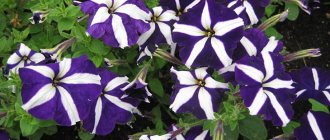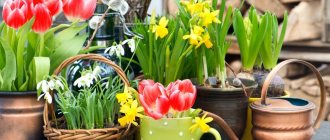The bulbous plant family represents a special group of herbaceous flower fruits that have a dense, shortened and multi-layered shoot - a bulb (corm). This name was assigned to them due to the similarity with the appearance and type of onion root.
Bulbous flowers are widespread both in the wild and in home cultivation. For seeds of this species, the climate of hot countries is most suitable for natural growth: South America, Central and Southern Africa, Southeast Asia.
Bulbous plants are divided into four large families, each of which has several varieties: Amaryllis, Liliaceae, Asparagus, Iris.
Amaryllis belladonna
Amaryllis belladonna is a beauty with bright pink, lily-like blooms. This plant is native to South Africa.
Amaryllis bulbs are planted in April. In May, after the bulb awakens, leaves appear on the plant, which die off in June. After two months, flower stalks and buds form on the stem, which bloom in late summer.
In warm and temperate climates, Amaryllis belladonna can overwinter in mulched soil. If your area has harsh winters, the bulb should be dug up after the above-ground part of the plant dies and stored indoors at a temperature of 13°C.
| Bloom | Aug. Sept |
| Plant height | 60-90 cm |
| Planting depth | about 10 cm (the neck of the bulb should protrude slightly from the ground) |
| Distance between bulbs | 20 cm |
| Underground part | bulb |
| Light requirements | |
| Purpose | |
Diseases and treatments
Bulbs are affected by many diseases and pests. The most common are:
- fusarium,
- botrytiosis, or gray mold,
- bacterial rot,
- viral variegation and streaking of leaves,
- bulb mite,
- bulb fly, etc.
Compliance with the rules of agricultural technology, proper care and storage, as well as preventive treatments of bulbs before planting and plants when signs of damage appear will prevent massive damage to plants.
To treat the bulbs, use a solution of potassium permanganate, a suspension of topsin, foundationazol and other fungicides, as well as karbofos, actellik.
When spots appear on the leaves, spray with Bordeaux mixture. Any plants or bulbs showing signs of damage should be removed immediately to prevent the spread of the disease.
The most common bulbous crops are lilies, tulips, daffodils, hyacinths and a large group of so-called small-bulbous crops, such as galanthus, muscari, chionodoxa, scillas, etc.
Read further on this topic: bulbous flowers in the garden.
If you find an error, please select a piece of text and press Ctrl+Enter.
Bletilla striped
This orchid comes from Asia, but has taken root well in our area. The most common color of bletilla is deep pink (for example, in varieties such as Bletilla striped Hyacinth or Hebina), but there are also varieties with white flowers (Alba - completely white and Albostriata - with white stripes).
Bletilla can be propagated either by seeds or by dividing the roots. In the second case, a part with four pseudobulbs is separated from the root system and planted in a separate container.
Plants need to be replanted every 2-3 years.
| Bloom | June July |
| Plant height | 20 cm |
| Planting depth | 3 cm |
| Distance between bulbs | 10 cm |
| Underground part | pseudobulb |
| Light requirements | |
| Purpose | |
What is a tuber
A tuber is usually called a thickened and modified root - an underground stem shoot of some plants. It has dormant buds, usually with one or more internodes (for example, like potatoes or Jerusalem artichokes), or a dense subcotyledon (a prominent representative is cyclamen).
Tuberous plants are represented by a wide variety of species, but the largest group is represented by flowers, among which there are perennials and annuals, indoor and wild specimens. In addition, tuberous plants can be divided into types based on the characteristics of the underground part. Here they usually talk about root tubers and corms.
Galtonia whitish
Another name for this South African plant is whitish hyacinth. This is a tall snow-white flower that will fill the garden with a delicate aroma. One to two dozen bell-shaped inflorescences are formed on one plant.
Galtonia is perfect for flower beds, mixborders or container plantings.
Galtonia does not really like transplanting and blooms well in one place for 4 seasons.
| Bloom | July-September |
| Plant height | 90-120 cm |
| Planting depth | 15 cm (to the height of the bulb) |
| Distance between bulbs | 20 cm |
| Underground part | pseudobulb |
| Light requirements | |
| Purpose | |
Hymenocallis
This Peruvian native goes by many names: Hymenocallis, Summer/Sea/Peruvian Narcissus, Lily of the Nile, Spider Lily. Such an abundance of names is awarded to a fragrant flower with white-yellow flowers of a bizarre shape on a long stem without leaves.
Hymenocallis loves sunny areas protected from the wind. When grown in containers, one plant requires a pot with a diameter of 13 cm. This flower also looks great in bouquets.
The most popular varieties of Hymenocallis have white flowers : Advance, Festalis Zwanenburg, Harrisiana. A decent variety with creamy yellow flowers is Salfur Queen.
| Bloom | June July |
| Plant height | 30-60 cm |
| Planting depth | about 10 cm (the bulb should protrude from the ground) |
| Distance between bulbs | 20 cm |
| Underground part | bulb |
| Light requirements | |
| Purpose | |
Krinum
Crinum is a late flowering bulbous plant native to South Africa. Crinum inflorescences are most often dark pink or white.
This plant is quite heat-loving, so it is most often grown in pots, covered or brought indoors during frosts. When grown in the ground, it is planted separately from its “relatives” - crinum loves privacy.
The most popular varieties are Powella (pink) and Powella Alba (white).
| Bloom | Aug. Sept |
| Plant height | 60-120 cm |
| Planting depth | 15-20 cm (the neck of the bulb should remain above the ground) |
| Distance between bulbs | 45 cm |
| Underground part | bulb |
| Light requirements | |
| Purpose | |
Levcocorina
Levkokorina comes from Chile, but its name is Greek - translated as “white mace”. Although its inflorescences are not only white, but also purple. Leucocorina resembles freesia in many ways.
In warm climates, this bulbous plant is grown in flower beds and in group plantings; in cold climates, it is often grown in containers. Levcocorina is also great for bouquets.
Of the 12 known species of Leucocorina, 7 are the most common: Ixioid, Coquimbensis, Macropetala, Purpurea, Alliacia, Angustipetala, Appendiculata.
| Bloom | Aug. Sept |
| Plant height | 50 cm |
| Planting depth | 3-4 cm |
| Distance between bulbs | 1.5-2 cm (10 bulbs per pot with a diameter of 15 cm) |
| Underground part | small bulbs |
| Light requirements | |
| Purpose | |
Types of bulbous perennials
Garden bulbous perennial flowers include many types of plants that differ not only in external characteristics, but also in their flowering period.
There are several types of bulbous perennials:
- corms;
- small-bulbous;
- bulbous.
All of them belong to perennials, the underground part of which (bulbs) retains all the necessary microelements and nutrients for flower growth.
When choosing perennials, you should pay attention to the seasonality of flowering to ensure its continuity when laying out the site:
- Spring specimens and primroses. The earliest flowers include perennials such as crocus, scilla, maskari, and snowdrop. With the onset of warm weather, daffodils, tulips, irises and hyacinths bloom.
- Summer bulbous. In the summer months, larger flowers with a stunning aroma and a variety of colors can be seen in the flower beds. These are lilies, dahlias, daylilies, callas, gladioli, freesia, etc.
- Autumn perennials. Flowers that are not afraid of cold weather and continue to delight the eyes of others are crocuses, crocuses and cyclamen.
To choose the right varieties, you need to carefully study not only the characteristics of bulbous perennials, but also look at their photographs. This will help in creating an original planting that will bloom almost continuously.
Lily
Lily is one of the most ancient flowers known in Europe and Asia. For several millennia it has delighted flower growers with its appearance and delicate aroma.
Lilies look beautiful in single plantings, but they are most impressive when planted in groups against the backdrop of dark green shrubs or in a mixborder along with dark blue and purple flowers. Considering that in nature these plants often grow in the mountains, they are suitable for growing in a rocky garden, at the foot of a rock garden. If desired, lilies can also be grown in containers.
If a lily does well in your flower garden, it can grow in one place for many years.
The most popular varieties of lilies belong to the group of Asian hybrids : Alaska (white), Compass (orange), London (yellow), Tuscany (pink), Gran Paradiso (red), etc. From the group of Oriental hybrids, the following varieties are often grown: Acapulco (hot pink), Casa Blanca (white), Mona Lisa (pink), etc. There are also various varieties of North American hybrids, Tubular, Curly, Long-flowered lilies , which are less common in our country.
| Bloom | June August |
| Plant height | 70-100 cm |
| Planting depth | 15 cm |
| Distance between bulbs | 30 cm |
| Underground part | bulb |
| Light requirements | |
| Purpose | |
Small-bulbous perennial primroses
There are also small-bulbous perennials that bloom in early spring. All of them are similar in the type of underground part and its size. Despite the fact that the bulb is shaped like a chicken egg, the plants grow very tall and quite strong. Therefore, they are not afraid of such surprises of nature as gusts of wind, heavy rains, etc.
Muscari (mousine hyacinth)
Viper onion, mouse hyacinth and muscari are all names of the same flower, which belongs to the Asparagus family. Muscari bloom during the period of active snow melting, bloom for a long time and are even used for cutting. There are several types of muscari, of which the following varieties are the most common:
- Bunch-shaped;
- Broadleaf;
- Pale;
- Crested;
- Oshe. The white inflorescences are very similar to a group of small bells that are pressed tightly together. Oshe is one of those flowers that are visited by the first bees and wasps to wake up after winter. Therefore, it is not recommended to plant the plant near a living space;
- Pretty. The plant can be planted on alpine hills; it tolerates poor soils well, and, in general, does not require care. The bulbous perennial is considered one of the most beautiful flowers that can grow on rocky open surfaces.
Iris reticulum
The reticulated iris is an early representative of perennial bulbous flowers that opens its buds as early as March. To ensure the annual flowering of this type of irises, it is necessary to plant new bulbs every fall for 3-4 years, and annually dig up the children and plant them again in another place. The tubers must replace each other, since this flower opens buds, and the children formed from the bulb bloom only after 3 years.
Snowdrop
Galanthus, or snowdrop, is most adored by all gardeners. Its buds appear along with the foliage as soon as the snow begins to melt, and continue to delight the eye, despite the dull weather, frosts and precipitation in the form of snow.
Among the 18 species of snowdrop, the most common varieties are:
- Alpine;
- Caucasian;
- Bortkevich;
- Cilician;
- Folded;
- Broadleaf.
Scilla (Scylla)
Scylla, or scilla, is an early flower from the asparagus family, which blooms in March. In total, 90 species of plants are known, among which the following varieties are most popular:
- Endymion Spanish;
- Scilla bifolia;
- Peruvian;
- Siberian;
- Armenian.
Nerine
Nerine was brought to Europe from South Africa, although one of its names, the Guernsey lily, was given in honor of the British island in the English Channel. Another name for this flower is Lucoris radiata.
This bulbous plant loves sunny, wind-free areas and can be grown in containers or border plantings. Perfect for bouquets.
The color of nerina petals can be varied: white, yellow, orange, red, pink.
The two most popular types of nerine are Bowden and Sarnia . Both of them bloom in September-October, but the leaves of Nerine Bowden plants have already dried out by this time, while the foliage of Nerine Sarnia begins to grow only after the end of flowering.
| Bloom | September October |
| Plant height | 35-90 cm |
| Planting depth | about 15 cm (the neck of the bulb should remain above the ground) |
| Distance between bulbs | 20 cm |
| Underground part | bulb |
| Light requirements | |
| Purpose | |
Modified underground shoots: rhizome, tuber, bulb, corm.
Rhizome is an underground shoot of perennial herbs, subshrubs and shrubs. Externally, the rhizome is similar to the root, but differs from it in its horizontal location in the soil, the presence of scale-like leaves, scars from fallen buds and adventitious roots. An apical bud develops at the top of the rhizome, and axillary buds develop in the axils of the scales. From the buds of the rhizome, above-ground shoots develop annually, dying off in the fall. The internal structure of the rhizome is typically stem. Most often, the rhizome is an organ of vegetative propagation, and in a number of plants (water lily, lily of the valley) it serves as a storage place for nutrients.
A tuber is a modified shoot with a very thickened stem in which nutrients are stored. They appear as thickenings on a thin underground shoot - the stolon. The place where the tuber attaches to the stolon is called its base. The tuber has apical and lateral buds - eyes. Tubers are formed in plants such as potatoes and Jerusalem artichokes. They perform a storage function and are organs of vegetative reproduction.
The bulb is a short underground shoot with succulent leaves attached to a short stem - the bottom.
At the top of the bottom there is an apical bud, in the axils of the succulent scales there are lateral buds, giving rise to young baby bulbs. The succulent scales store reserve nutrients. The outside of the bulb is often covered with dry scales that play a protective role. Bulbs are formed in onions, lilies, garlic, and tulips.
The corm is similar in appearance to an onion, but differs from it in its highly overgrown bottom, where nutrients are stored. On top it is covered with dry filmy leaves. The corm has well-developed apical and axillary buds, giving rise to flowering shoots and baby corms. Corms are formed in colchicum, gladiolus, and saffron.
Fig.27. A-rhizome: 1-lily of the valley, 2-wheatgrass; B-potato tubers, B-bulbs: 1-onion, 2-lily-saranka, 3-tulip; G-crocus corm.
Sheet
A leaf is a lateral vegetative organ growing from a stem, having bilateral symmetry and a growth zone at the base. Main functions of the sheet:
- depot of reserve nutrients;
-organ of vegetative reproduction.
The leaves of most plants have a petiole and a leaf blade. Leaves that do not have a petiole are called sessile.
Leaves can be simple or compound. Simple leaves have one leaf blade. A compound leaf consists of several leaf blades attached to a common petiole using their own petioles.
Fig.28. The leaves are simple and complex: 1-lilac, 2-apple, 3-maple, 4-clover, 5-dandelion, 6-rosehip, 7-raspberry, 8-strawberry, 9-lupine.
The leaves are arranged on the stem in a certain order. Leaf arrangement
there are three types: regular
— one leaf per stem node (birch, poplar);
opposite
- two leaves extend from the node, located opposite each other (maple, lilac);
whorled
- at least three leaves extend from the node (bamboo).
Fig.29. Leaf arrangement: 1 - alternate; 2-opposite; 3- whorled
In addition, leaves differ in the type of venation. Veins
- These are vascular-fibrous bundles, clearly visible on the leaf blade. They perform mechanical and conductive functions. There are three main types of venation: reticulate, parallel and arcuate. Reticulate venation
subdivided into
pinnate:
smaller ones extend from the main vein (oak, aspen);
and palmate:
the main veins extend from the base of the leaf blade (maple).
Such venation is more common in dicotyledonous plants. For monocotyledonous plants, parallel
veining is more typical: the veins are located parallel to each other (wheat, corn);
and arcuate
- the veins are arranged in the form of arcs (lily of the valley).
Ornithogalum
Alternative names: birdwort, Star of Bethlehem, chincherinchiz.
This South African bulb does not tolerate low temperatures very well, so it is recommended for growing in warm regions. Ornithogalum blooms profusely for several months and remains fresh for a long time when cut, so it is ideal for bouquets.
The flowers of this plant are white.
The most common tall varieties are Arabicum (80 cm) and Saundersea (100 cm). Plants of these varieties have flowers collected in a pyramidal raceme. In addition, Arabicum has a black ovary. Another popular variety is Thyrsoid (35 cm).
| Bloom | June-October |
| Plant height | 10-100 cm (depending on type) |
| Planting depth | 5-10 cm (to the height of the bulb) |
| Distance between bulbs | 8-12 cm (depending on the size of the bulb) |
| Underground part | bulb |
| Light requirements | |
| Purpose | |
Game of colors
The selection of colors depends on the appearance of the house.
Colors come in warm and cool colors. To obtain contrasting combinations, you should combine cold and warm shades. To achieve harmony, colors that are similar in tone are used. Almost every garden uses white colors.
You should use the same color scheme in every corner of the garden to avoid oversaturation.
The basic rule is to use no more than 3 shades. There is one more nuance - harmony is achieved with a color ratio of 70:15:15.
Ranunculus
Ranunculus is called the Persian (or Asian) buttercup. This is a favorite flower of florists who use it in a variety of compositions, especially peony and double varieties.
This charming plant blooms all summer. It can be grown in flower beds or as a border in well-lit areas.
Before planting, ranunculus corms are soaked in water for an hour, and after planting, the soil is watered well.
| Bloom | June August |
| Plant height | 30-60 cm |
| Planting depth | 2-5 cm |
| Distance between bulbs | 8 cm |
| Underground part | corms with corms |
| Light requirements | |
| Purpose | |
Blooms in late spring
The most popular spring garden flowers are perennial bulbous ones that bloom closer to summer:
- decorative onion - very original in appearance, it must be planted in a sunny place and so that there are no gusts of wind;
- summer white flower garden - white violet, begins to bloom at the end of May.
Sauromatum
Sauromatum is a very unusual plant that came to us from the tropical part of Africa. It blooms with yellow-orange flowers with purple specks.
This bulbous exotic is grown in containers or individual pots. It is best to place sauromatum on verandas, balconies, and patios away from direct sunlight. This bulbous plant prefers soft, indirect light.
Sauromatum, like any tropical plant, loves moist, well-drained soil flavored with organic matter.
| Bloom | end of May – June |
| Plant height | 45 cm |
| Planting depth | 15-20 cm |
| Distance between bulbs | 8 cm |
| Underground part | large tuber |
| Light requirements | |
| Purpose | |
Feeding is important!
Fertilization is a necessary condition for plants of any kind. This also applies to tuberous begonia, which requires systematic feeding when planting and caring for it. You need to start it during early planting. During this period, nitrogen fertilizers are best suited, the elements of which stimulate shoot growth and stop the onset of flowering. The amount of such substances should not exceed the norm specified in the instructions. Otherwise, the onset of the flowering period will be greatly delayed, and the shoot will become “fat.”
Begonia develops and blooms well in soil that is rich in organic matter. If the plant is wilting, there may be a lot of lime in the substrate. Organic and mineral fertilizing should be alternated with an interval of 2 weeks. Systematic application of fertilizers begins from the moment of transplantation and ends with flowering. Approximately this period lasts from May to October.
Tigridia
This Mexican bulbous plant was so named because of its very characteristic “tiger” coloration. Moreover, the color of the outer petals may vary depending on the variety: cream, white, yellow, red, pink. But the core of the flowers seems to be strewn with variegated spots.
An interesting feature of tigridia is that each flower blooms for only 1 day. Fortunately, several buds are formed on one plant.
This plant is also popularly called tiger flower.
| Bloom | July-October |
| Plant height | 45-60 cm |
| Planting depth | 8 cm |
| Distance between bulbs | 10-14 cm |
| Underground part | corm |
| Light requirements | |
| Purpose | |
Tritonia
This South American plant loves warm, well-lit areas. In the southern regions, it can be grown in border plantings or flower beds without digging up the bulb for the winter. In colder climates, it is best to plant tritonia in containers.
This is a very beautiful flower, the color of its petals varies depending on the variety, but most often red-orange shades predominate.
The tritonia bulb may rot due to excessive watering.
| Bloom | June-August, in nature September-November |
| Plant height | 30 cm |
| Planting depth | 5 cm |
| Distance between bulbs | 8-10 cm |
| Underground part | bulb |
| Light requirements | |
| Purpose | |
Galanthus (snowdrop)
Galanthus is one of the first to inform us about the arrival of spring, showing its delicate white heads almost from under the snow - in fact, that’s why it was popularly called “snowdrop”. It blooms in March-April.
The time for autumn planting of galanthus is the end of August or the beginning of September, although this primrose can be planted as early as July. It is important to remember that snowdrop bulbs do not tolerate drying out. Therefore, when purchasing, make sure that they are strong and moisturized. And if you are replanting a plant on your site, do not leave it in the air for more than a day - move it immediately after digging it up from its original place.
It is customary to plant snowdrops in groups of 5-10 bulbs, keeping a distance of 3-5 cm between them. Since galanthus is a small-bulbed plant, it is planted to a depth of approximately 5-7 cm.
The snowdrop is not a fan of transplants - it is worth giving it a permanent place in the garden and not disturb it again.
Eucomis
The small flowers of this bulbous plant are collected in a long cylindrical raceme, which is crowned with a green “comb” of leaves.
It is best to grow eucomis in individual pots or large containers of several plants in order to be able to bring the container indoors for the winter. There is no need to dig up the bulb. During the dormant period, the plant, like other bulbous plants, does not need to be watered.
In its homeland, South Africa, eucomis grows on damp mountain slopes, so during the period of active growth and flowering it needs good moisture, as well as regular feeding.
If you live in the south, then you can easily afford to grow eucomis in border plantings, in rock gardens, or in a flower bed.
Among flower growers, the most popular are Eukomis bicolor (green), Eukomis bicolor alba (white), Eukomis komosa, also crested (mixed green and white).
| Bloom | July August |
| Plant height | 30-60 cm |
| Planting depth | 5-6 cm (the bulb should be completely covered with soil) |
| Distance between bulbs | 8-10 cm |
| Underground part | bulb |
| Light requirements | |
| Purpose | |
Tuberous plants: description
Tubers are short shoots of plants with axillary buds that have a rounded shape. They develop at the ends of elongated shoots of the rhizome. The tubers store a large amount of nutrients that plants use to feed themselves during winter or drought to extract the energy needed to restore growth the following season.
Tubers come in stem and root varieties and are used for plant propagation:
- Stem tubers usually form on the subcotyledonous knee, which is located below the cotyledonary node. Often, such tubers have one or two epicotyledonous knees - plant parts of seedlings between cotyledons with developed leaves. Stem tubers have a vertical direction of germination and an ovoid shape. At the narrowed end there are several vegetative buds.
- Root tubers form on the sides of the parent plant and are located shallow underground. Many such tubers live as long as the plant grows and develops, after which they die. But the tubers of some plants, for example, begonias, can live long and give life to several generations of plants.
The variety of tuberous plants allows gardeners to grow them both in the garden and at home.











